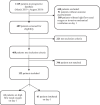High-flow nasal oxygen in patients with COVID-19-associated acute respiratory failure
- PMID: 33573680
- PMCID: PMC7876530
- DOI: 10.1186/s13054-021-03469-w
High-flow nasal oxygen in patients with COVID-19-associated acute respiratory failure
Abstract
Purpose: Whether the use of high-flow nasal oxygen in adult patients with COVID-19 associated acute respiratory failure improves clinically relevant outcomes remains unclear. We thus sought to assess the effect of high-flow nasal oxygen on ventilator-free days, compared to early initiation of invasive mechanical ventilation, on adult patients with COVID-19.
Methods: We conducted a multicentre cohort study using a prospectively collected database of patients with COVID-19 associated acute respiratory failure admitted to 36 Spanish and Andorran intensive care units (ICUs). Main exposure was the use of high-flow nasal oxygen (conservative group), while early invasive mechanical ventilation (within the first day of ICU admission; early intubation group) served as the comparator. The primary outcome was ventilator-free days at 28 days. ICU length of stay and all-cause in-hospital mortality served as secondary outcomes. We used propensity score matching to adjust for measured confounding.
Results: Out of 468 eligible patients, a total of 122 matched patients were included in the present analysis (61 for each group). When compared to early intubation, the use of high-flow nasal oxygen was associated with an increase in ventilator-free days (mean difference: 8.0 days; 95% confidence interval (CI): 4.4 to 11.7 days) and a reduction in ICU length of stay (mean difference: - 8.2 days; 95% CI - 12.7 to - 3.6 days). No difference was observed in all-cause in-hospital mortality between groups (odds ratio: 0.64; 95% CI: 0.25 to 1.64).
Conclusions: The use of high-flow nasal oxygen upon ICU admission in adult patients with COVID-19 related acute hypoxemic respiratory failure may lead to an increase in ventilator-free days and a reduction in ICU length of stay, when compared to early initiation of invasive mechanical ventilation. Future studies should confirm our findings.
Keywords: Acute hypoxemic respiratory failure; COVID-19; High-flow nasal oxygen; Ventilator-free days.
Conflict of interest statement
A. Torres reports lecturing or consultancy fees from Pfizer, MSD, Basilea, Biomerieux. Jansen. L. Brochard's laboratory reports grants from Medtronic Covidien, grants and non-financial support from Fisher Paykel, non-financial support from Air Liquide, Sentec, Philips, and a patent with General Electric, outside the submitted work. The remaining authors declare no conflicts of interest in relation to this manuscript.
Figures


References
Publication types
MeSH terms
Grants and funding
LinkOut - more resources
Full Text Sources
Other Literature Sources
Medical

